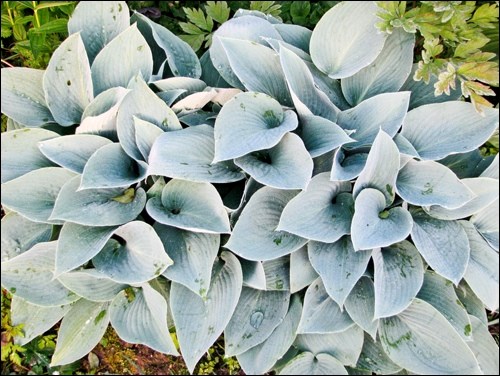If last summer was any indication of what the coming summer holds for us, slugs may be included. Especially, if our spring, summer or fall is humid and rainy. On the more optimistic side, the cold temperatures experienced earlier this winter when we had little insulating snow cover, might mean the slugs (alas, along with your favourite strawberries) may be fewer in number.
When you read the term "resistant,” it doesnt mean immune. Like deer, if slugs are high enough in number, and the weather suits them, theyll eat just about anything. But given a choice, they are less likely to eat the hostas listed below. Why are these less palatable to slugs? Because their foliage is thicker, more textured and leathery. Slugs, like people, dont like their meals overly tough.
Slugs are best described as a snail without a shell. They are hermaphroditic, each having both male and female parts. But in order to produce fertile eggs, an individual must mate with another slug. Slugs are cream-coloured brown or black and generally less than an inch long. They are coated in mucus that prevents moisture loss, facilitates movement, and leaves "slime trails.” They also leave large irregular holes in the leaves of your favourite plants.
Hostas are grown mainly for the striking green, blue, gold or bi-coloured foliage. Their lovely flowers, generally blooming in August, should not be undervalued. Place hostas in full or partial shade in well drained soil into which generous amounts of organic matter has been incorporated. Keep them evenly moist. Mulch with four inches of post peelings to conserve moisture, reduce weeding and deter slugs. Their tender bodies are easily lacerated by the coarse post peelings leading to dehydration and death.
Slug Control
Before planting, carefully inspect new plants for slugs or their eggs. Check the pots as well as the soil. If possible, use drip irrigation to keep the soil surface dry. Handpicking slugs works if carried out with determination and consistency at dawn or dusk. Drop the slugs into a container of soapy water. Slugs will collect under boards where its cool, dark and damp. Check them every morning with your pail of soapy water in hand. Lure slugs with a "beerless" beer trap made of yeast, sugar and water in a saucer at soil level. Once drowned, drink a real beer to your trapping success. Use slug baits containing iron phosphate that inhibits their ability to eat, causing death within a day or two. Apply diatomaceous earth.
A few of the "slug-resistant" hostas:
Halcyon - 40 x 60 centimetres, heavily ribbed blue foliage and violet flowers.
Hadspen Blue - 30 x 60 centimetres, medium size, intensely blue, heart-shaped leaves with bell-shaped lavender flowers.
June - 25 x 50 centimetres, medium hosta with oval to lance-shaped bluish-green leaves with a yellow centre and white flowers.
Great Expectations - 60 x 70 centimetres, golden leaves with a wide blue margin and white flowers.
Blue Umbrellas - 90 x 100 centimetres, large hosta with glacous blue leaves that curve downward and white flowers.
Invincible - 30 x 60 centimetres, wedge-shaped green leaves and lavender flowers.
Krossa Regal - 75 x 100 centimetres, large, wavy-edged bluish green leaves with funnel-shaped lavender flowers.
Sum and Substance - 75 x 150 centimetres, enormous greenish-gold leaves and white flowers.
Abiqua Drinking Gourd - 45 x 80 centimetres, medium sized plant with frosty blue, cupped leaves and white flowers; 2014 Hostas of the Year.
Big Daddy - 75 x 120 centimetres, large, deep blue leaves with white flowers.
Sara is the author of numerous gardening books, among them the revised Creating the Prairie Xeriscape. And with Hugh Skinner: Gardening Naturally; Trees and Shrubs for the Prairies, and Groundcovers & Vines for the Prairies. Expect Fruit for Northern Gardens with Bob Bors in November 2017.
— This column is provided courtesy of the Saskatchewan Perennial Society (www.saskperennial.ca; [email protected]; www.facebook.com/saskperennial). Check out our Bulletin Board or Calendar for upcoming garden information sessions, workshops, tours and other events.




